CSE 562
Database Systems
Oliver Kennedy
okennedy@buffalo.edu
133A Ketter Hall
Why are databases awesome?
They're everywhere
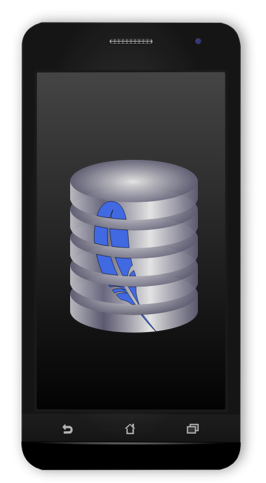
They combine everything
They're $$
| Rank | Organization | Sales | FY | Market cap | Headquarters |
|---|---|---|---|---|---|
| 1 | Microsoft | $97.58 | 2015 | $340.8 | Redmond, WA, US |
| 2 | Oracle | $38.8 | 2015 | $187.6 | Redwood City, CA, US |
| 3 | SAP | $23.3 | 2015 | $90.2 | Walldorf, Germany |
| 4 | VMware | $6 | 2015 | $35.7 | Palo Alto, CA, US |
| 5 | Symantec | $6.6 | 2015 | $16.3 | Mountain View, CA, US |
| 6 | HCL Technologies | $5.2 | 2015 | $21.1 | Noida, UP, India |
| 7 | Fiserv | $5.1 | 2015 | $19 | Brookfield, WI, US |
| 8 | Intuit | $4.6 | 2015 | $27.1 | Mountain View, CA, US |
| 9 | Amadeus IT Group | $4.5 | 2013 | $19.8 | Madrid, Spain |
| 10 | CA Technologies | $4.3 | 2015 | $14.3 | Islandia, NY, US |
7 out of the largest 10 software companies ($698.8bn out of $771.9bn)
make their money in databases (and most of the others are data-adjacent)
Ok... so what's "databases"?
Databases
Answering questions about data
- Ensuring Result Accuracy
- Combining Multiple Sources
- Making question-answering fast
- Summarizing big data
Safely making changes to data
- Preventing "buggy" data
- Keeping copies consistent
- Updating data in parallel
Techniques
- Data Modeling
- Cost-Based Optimization
Recipes
- Join Algorithms
- Index Data Structures
Knowledge
- The Memory Hierarchy
- Equivalence Rules
Which tools to use
... and when
This Course in Short
For X, the best, correct choice is Y, at least when Z
- How do you define 'correct' and 'best'?
- What correct alternatives are available?
- How do you find the best available alternative?
What is 'Better'?
- Declarative Queries: 'Easy to think about' vs 'Fast'
- Data Layouts: Space vs Fast Updates vs Fast Queries
- Parallel Updates: Reactive vs Proactive Concurrency
Today
- Logistics: What you need to know
- Project Outline: A relational query engine
- Ways to Fail: What not to do and why
- Intro: So what is a database anyway?
- SQL: Recapping everyone's favorite language
People
- Oliver Kennedy (okennedy@buffalo.edu)
Ketter 133A; Thu 2:00-3:00 - Liuyi Yao (liuyiyao@buffalo.edu)
Davis 338H; Mon 4:00-5:00 - Alex Stachnik (ajstachn@buffalo.edu)
Davis 338H; Wed 3:00-4:00
Syllabus & Website
https://odin.cse.buffalo.edu/teaching/cse-562
Course Project
http://dubstep.odin.cse.buffalo.edu
https://odin.cse.buffalo.edu/teaching/cse-562
Course Project
http://dubstep.odin.cse.buffalo.edu
http://dubstep.odin.cse.buffalo.edu
Course Structure
- Programming Assignment (50% of overall grade)
3-person Groups Build a Relational Query Engine - Theoretical Content (50% of overall grade)
- Midterm on March 4 (15% of overall grade)
- Midterm on Apr 8 (15% of overall grade)
- Comprehensive Final Exam (20% of overall grade)
Optional Textbook 1
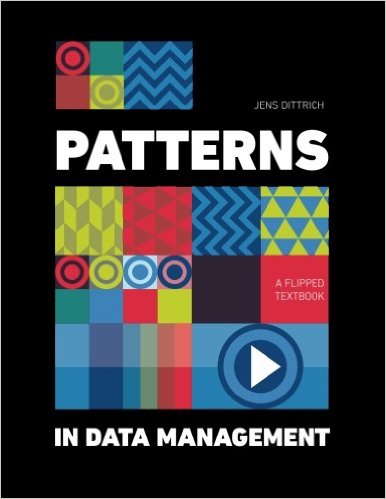
Optional Textbook 2
| Hardcover | Softcover |
|---|---|
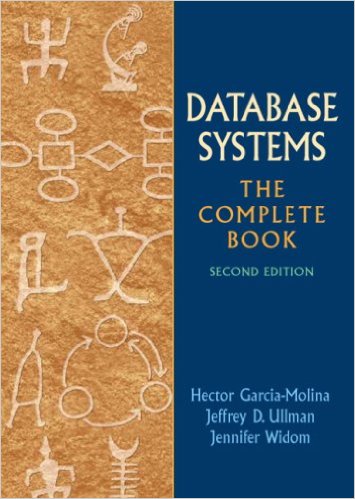
|
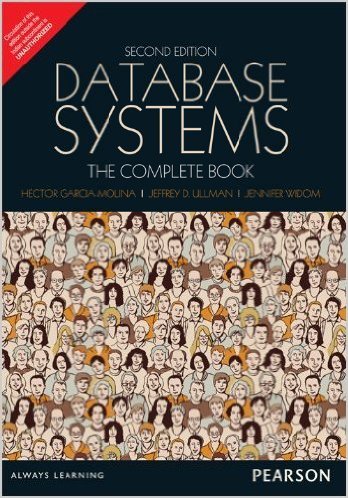
|
| $160 |
$25 |
| has Index, ToC | no Index, ToC |
Optional Textbook 3
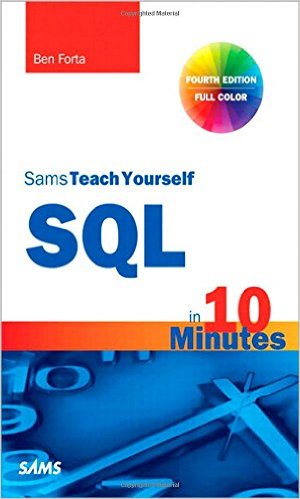
Course Project
Data µBases
Embedded Databases
- SQLite is in your browser, computer, phone, ...
- Declarative data management is awesome!
- Tech needs small data: Mobile, IoT, Web
Your team's goal:
build (part of) an embedded database
The Project
- I give you data (CSV Files + A Schema)
- I ask you questions about the data (SQL)
- You give me an answer
Real world challenge: You start with...
- ... an empty GIT repository
- ... a few open-source libraries
Real world challenge: You get graded on...
- ... Correctness
- Do you produce the right answer?
1/3 grade for computing the correct answer - ... Speed
- How fast did you produce the answer?
2/3 grade for meeting or beating the reference implementation
Submission
Query Processor
DµBStep
- Checkpoint 0: "Hello World" due Feb 10
SELECT * FROM FOO- Checkpoint 1: "Expressions" due Mar 9
SELECT A*23 FROM FOO WHERE B > 10- Checkpoint 2: "Precomputation" due Apr 13
SELECT SUM(A) FROM FOO WHERE B > 10- Checkpoint 3: "Joins" due May 11
SELECT SUM(A) FROM FOO, BAR WHERE B > 10
Getting Started
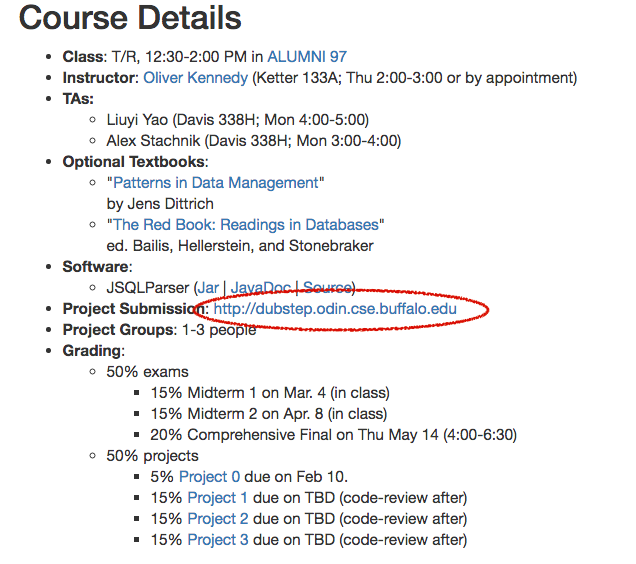
A link to the submission system is on the syllabus.

There's a handy "create account" link.
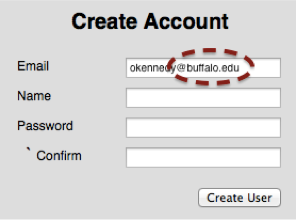
Use your UBIT email address to create an account.
TODO By Feb 10
- Create a group of up to 3 people
- Register your group
- Access your group's GIT repository
- Download JSQLParser
- Look at the JSQLParser Javadoc
- Read the Checkpoint 0 Overview
- Create a SQL "Hello World" program
- Hit Submit
A SQL "Hello World"
- Read SELECT * FROM [tablename] from System.in
- Use JSQLParser to parse the query
- You don't need to use JSQLParser... but it will make your life easier later.
- Get the Table Name
- Read in the file data/[tablename].csv
- Write the contents out to System.out
Submit as many times as you need to
Your grade will never ever decrease because you decided to submit just one more time
Ways to Fail
(please do not do these things)
- Start your project the weekend before it's due.
- Avoid your TAs and their office hours.
- Stay quiet in class when your professor says something you don't understand.
- Wait until the deadline to submit for the first time.
- Cheat.

Academic Integrity
Cheating is submitting any work that you did not do yourself, as if you did
- References (properly cited)
- Wikipedia, Wikibooks: OK
- Public Code
- StackExchange, GitHub: NOT OK
- Discussing concepts with classmates
- "HashTables have O(1) lookups": OK (except exams)
- Sharing code or answers with classmates
- "Just look at how I did it": NOT OK
MOSS
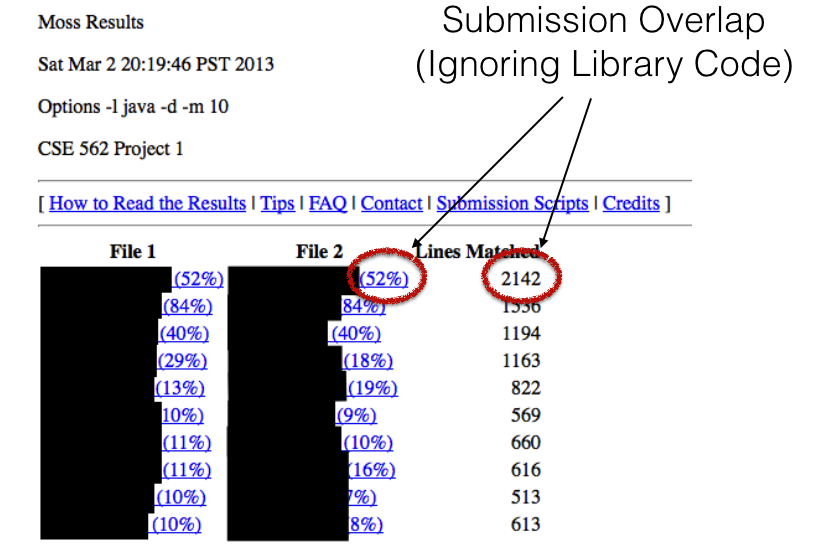
MOSS
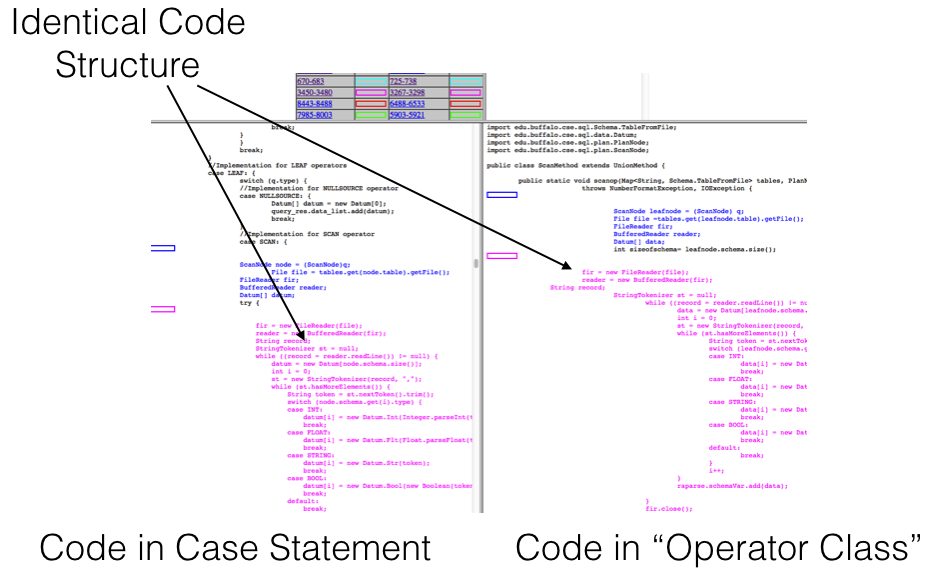
Academic Integrity
- Zero Tolerance
- If I catch you submitting someone else's code, you will fail the class.
- Group Responsibility
- If your teammate cheats on a group project, the entire group will be penalized.
- Share Code, Share Blame
- If someone else submits your code, you will be penalized as well.
Any Questions or Concerns?
What does a Database
Management System Do?
Data Management
- Analysis: Answering user questions about a dataset
- What kind of tools can we give users?
- Declarative Languages
- Organizational Datastructures (e.g., Indexes)
- Transactions: Safely saving and sharing changing data
- What kind of tools can we give users?
- Consistency Primitives
- Data Validation Primitives
Data
 vs
vs
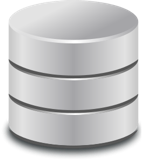
Files
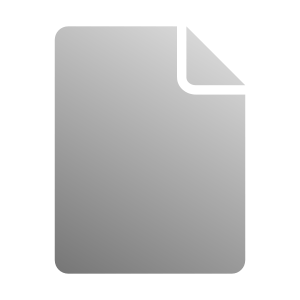
Databases
{
"firstName": "John", "lastName": "Smith","age": 25,
"address": {
"streetAddress": "21 2nd Street",
"city": "New York", "state": "NY",
"postalCode": 10021
},
"phoneNumbers": [
{ "type": "home",
"number": "212 555-1234"
},{ "type": "fax",
"number": "646 555-4567"
}
]
}Databases understand and exploit the data's structure
Types
- Primitives
- Integer, String, Floating Point Number, Date
- Collections
- List/Array, Set, Bag
- Tuple
- Struct, Dictionary/Object
Type Glossary
- Primitive
- Basic Building Blocks
- Tuple (aka Record)
- Several 'fields' of different types
(a schema defines names/types for each field) - Set
- Collection of unique records all of the same type.
- Bag
- Unsorted collection of records of the same type.
- List
- Sorted collection of records of the same type.
Relational Database Glossary
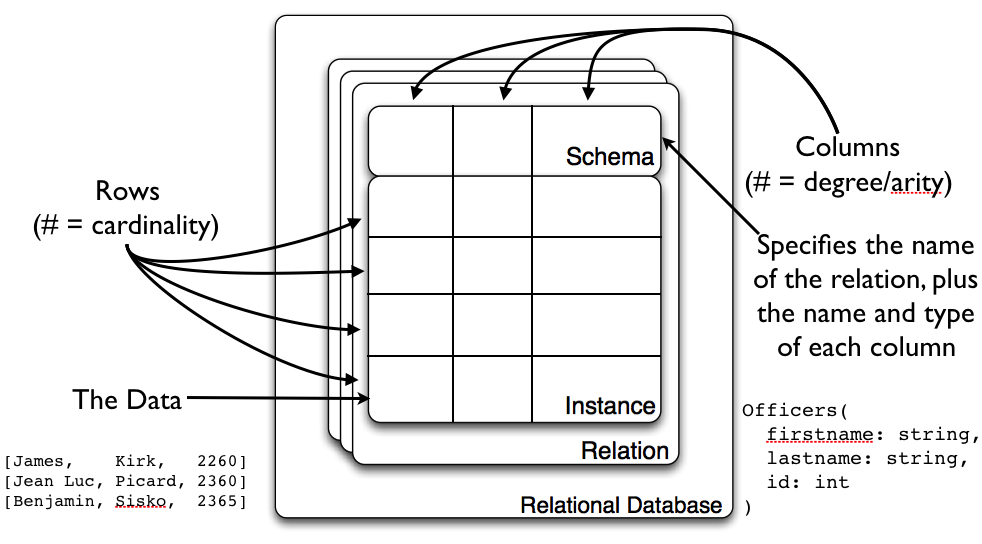
Your data is currently an unsorted set
of 100-attribute Tuples.
Tomorrow, you will be repeatedly asked for the value of 1 specific attribute from 5 specific rows, each identified by a 1 specific attribute.